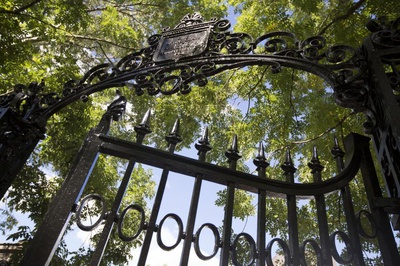
News
Harvard Grad Union Agrees To Bargain Without Ground Rules

News
Harvard Chabad Petitions to Change City Zoning Laws

News
Kestenbaum Files Opposition to Harvard’s Request for Documents

News
Harvard Agrees to a 1-Year $6 Million PILOT Agreement With the City of Cambridge

News
HUA Election Will Feature No Referenda or Survey Questions
Summer Art: Vignettes by The Crimson’s Arts Board

With cold air returning to the streets of Harvard Square, The Crimson’s Arts Board reminisces on their favorite artistic experiences from the seemingly long-ago summer.
Handprints, Photo Prints, and the Imprints of Community
Nestled in an archive on a hill outside of Florence, three sets of handprints adorn a church’s western portal in an early twentieth-century photographic print by Lucy Porter. Three children posed in front of the handprints are blurred by their animacy, one appearing to grin literally from ear to ear in the exposed commotion of his head’s rotation. Allowing myself to pause on this out of hundreds of photographs I was researching and cataloging, I couldn't help but imagine the children leaving their marks on the door’s slats and giggling as they brushed off their hands during the camera’s capture. This burst of life was a startling find in an archive dedicated to the academic photographs used by Harvard medievalist art historian — and Lucy’s husband — Arthur Kingsley Porter. I had to wonder: Why should the austere objectivity of an architectural site be contaminated with human animacy the photographic technology couldn’t even fully register? The photo seemed to reply that even art-historical study can’t deny that the building lives, continually renewed by the evolving influence of its human community.
Today, the handprints are long gone, as are the hands that made them. But the challenge they present for modern discourses of preservation and cultural heritage is still pressing: How will we acknowledge the significance of heritage sites in relation to their cultures and communities? In a time of increased threat to such spaces at the hands of a changing climate, raging conflicts, and more, the century-old children and their handprints entreat us to preserve these sites and their relationships with local and global communities. “All hands on deck!,” urge the handprints on the door.
—Staff writer Marin E. Gray can be reached at marin.gray@thecrimson.com.
From ‘Dali-fornia’ with Love
I confess, I was more interested in the artist than her art. I wanted to talk to one of the “drifters” and “dreamers” of “Dali-fornia,” as described by Vivian Wang in the New York Times article that I’d read before arriving in the artistic Chinese city.
I must’ve walked up and down the street 10 times, checking if she’d finished drawing her last client. I had finally stooped to ogling over her shoulder when she turned and asked, cheerfully, “Do you wanna go next?”
It was twilight on my last night in Dali; I walked alone, as I often did that summer.
Seated on the concrete steps, I asked her for her name as she sketched me.
“No one’s ever asked me that before,” she giggled. It was apparently more of an American question than I’d thought. Her name was Sisi — 21-years-old, not local, not a student, not employed?
As she colored in the sketch, her boyfriend — another artist, surely — disappeared at intervals, only to return with milk tea, grapes, or a bottle of pink liquor with furry cat ears. Sisi’s friend across the street, who sold needle-felted dogs, flaunted her own bottle. They shared a squeal.
Along the road back, young people sold used books and film slides under lamplight, sitting shoulder-to-shoulder in the shadows.
Abundance, somehow, in this convergence of drifters.
Here was the answer to all the career crises of that summer: Run away and draw strangers by the roadside, surrounded by all the other artists, drifters, and dreamers; live in a commune; stay young forever.
The portrait hangs on my wall now, beckoning me back to Dali.
—Staff writer Isabelle A. Lu can be reached at isabelle.lu@thecrimson.com.
Into Our World
Wandering along the monumental historic boulevard of Lisbon, past the historic, elegant architecture and murmuring of the effervescent city, I found myself in a peaceful oasis of flourishing flora and promenading lanes, at the Calouste Gulbenkian Museum. The radiant summer sun cast a warm glow over the scenery, as a flock of birds floated leisurely in the serene ponds.
My visit was quite serendipitous. It was one of my final days in the beautiful city, and I had not planned to see any museums in favor of savoring the natural and historical beauty of the cosmopolitan capital. Yet, in a chance conversation over dinner, our table neighbor ardently recommended the Gulbenkian, and I, drawn by the allure of its collections of European masters, found myself within the museum’s idyllic grounds the very next day.
I had fully expected myself to be immersed in the magnificent works, and yet, as I began to roam around the halls, I was enamored by the ambiance of every room. In every exhibit, soft natural light shone through the floor-to-ceiling windows, casting a dazzling luminance over the fine china and oil paintings. The natural scenery coalesced into the beauty of the art and illuminated the artworks in an entirely novel light with every step, imbuing the pieces with life. In this new light, the art I had been so familiar with embodied a new meaning.
As I departed the museum, I looked back through the blossoming branches at the glass, seeing the glimmering silhouettes. Art had come to life and into our world.
—Staff writer Leshui (Jade) Xiao can be reached at jade.xiao@thecrimson.com.
A City of Canals and Contemporary Art
This summer, I wound up in Italy — Venice, to be exact. What was I to do but go to the Biennale Arte? As a contemporary art fan, I knew I just had to go, and I am thrilled to say it did not disappoint. This over-seven-month-long affair on the island has two main venues requiring tickets — the Giardini and the Arsenale — and a myriad of collateral events.
“Stranierni Ovunque — Foreigners Everywhere,” the title of this year’s Biennale Arte, was the 60th exhibition and the first time Ethiopia, the United Republic of Tanzania, the Republic of Benin, and the Democratic Republic of Timor Leste participated. Each of the 86 national contributions offered an unmatched opportunity to experience a deeply personal and cultural exploration of what it means to represent an entire country on a truly international stage. Venice is a life-changing destination in and of itself, but the Biennale Arte epitomized contemporary art by highlighting complex, global issues in a beautifully thought-provoking exhibition of so many identities.
—Staff writer Madelyn E. McKenzie can be reached at madelyn.mckenzie@thecrimson.com.
Stillness of Time
One hot summer day, I climbed onto a bus on Long Island to make the multi-hour trek into New York City. I had appointments in the city, and these were the days I dreaded more than any other. I love the city — though not when my days are packed from start to finish with yearly check-ups, appointments, and errands.
On this day, after walking what felt like hundreds of blocks, I decided to pop into The Met to check out the Leonard N. Stern Collection of Cycladic Art. Although the collection had only just arrived at The Met several months prior, I was already familiar with some of the artifacts — I had spent five weeks working at The Museum of Cycladic Art in Athens during the previous summer where several pieces of the same collection were exhibited before embarking on their American tour.
Amid the loud, fast-paced, and sweltering day, I walked slowly through the cool, grand galleries of The Met, looking upon the simple yet intricate, austere yet familiar, and ancient yet modern marble figurines that I had gotten to know so well during the last summer. These figures, with their simple folded arms, remind me of the subjectivity of time. I feel like I’ve changed and grown over the last year, but not these statues — they’re exactly as they’ve been since their creation, thousands of years ago.
—Staff writer Thomas A. Ferro can be reached at thomas.ferro@thecrimson.com.
Want to keep up with breaking news? Subscribe to our email newsletter.
From Our Advertisers

Over 300+ courses at prestigious colleges and universities in the US and UK are at your disposal.

With innovative financial tools combined with financial education, Collegiate empowers students to take control of their finances and build confidence in their money management skills.

Serve as a proctor for Harvard Summer School (HSS) students, either in the Secondary School Program (SSP), General Program (GP), or Pre-College Program.

With an increasingly competitive Law School admissions process, it's important to understand what makes an applicant stand out.

Welcome to your one-stop gifting destination for men and women—it's like your neighborhood holiday shop, but way cooler.

Admit Expert is a premium MBA admissions consulting company, helping candidates secure admission to top B-schools across the globe with significant scholarships.
